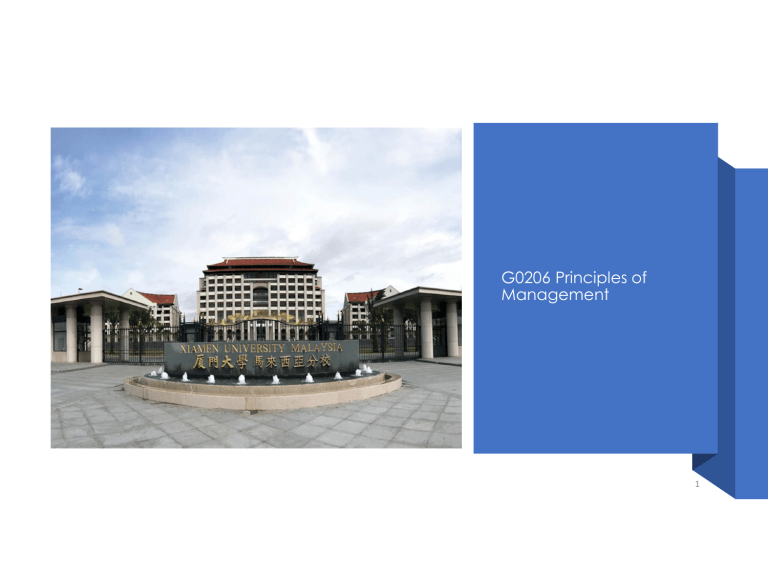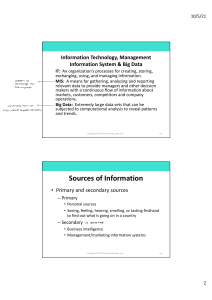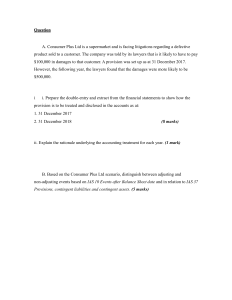
G0206 Principles of Management 1 7 Foundations of Planning and Strategy Copyright ©2017 Pearson Education, Ltd. 5-2 Learning Outcomes Discuss the nature and purposes of planning. Explain what managers do in the strategic management process. Compare and contrast approaches to goal setting and planning. Discuss contemporary issues in planning. Copyright ©2017 Pearson Education, Ltd. 5-3 Discuss the nature and purposes of planning. Copyright ©2017 Pearson Education, Ltd. 5-4 What is Planning? Planning: the primary management function. Copyright ©2017 Pearson Education, Ltd. 5-5 Reasons for Planning Copyright ©2017 Pearson Education, Ltd. 5-6 Criticisms of Formal Planning • May create rigidity • Can’t replace intuition and creativity • Focuses attention on today’s success, not tomorrow’s survival • Reinforces success, which may lead to failure Copyright ©2017 Pearson Education, Ltd. 5-7 Formal Planning and Organizational Performance Does it pay to plan? Higher profits Higher return on assets Improved quality of planning Appropriate implementation Copyright ©2017 Pearson Education, Ltd. 5-8 Explain what managers do in the strategic management process. Copyright ©2017 Pearson Education, Ltd. 5-9 Strategic Management • What managers do to develop an organization’s strategies Copyright ©2017 Pearson Education, Ltd. 5-10 The Importance of Strategic Management It has a positive impact on organizational performance It prepares managers to cope with changing situations It guides managers to examine relevant factors in planning future action Copyright ©2017 Pearson Education, Ltd. 5-11 Steps in the Strategic Management Process Copyright ©2017 Pearson Education, Ltd. 5-12 Step 1: Identify Mission, Goals and Strategies Copyright ©2017 Pearson Education, Ltd. 5-13 External and Internal Analyses Step 2: External Analysis Competition Components of environment Threats and opportunities Step 3: Internal Analysis Resources Capabilities Core competencies Organizational strengths and weaknesses Copyright ©2017 Pearson Education, Ltd. 5-14 Formulating, Implementing, and Evaluating Results Step 4: Formulate Strategies Corporate Business Functional Step 5: Implement Strategies Step 6: Evaluate Results How effective have strategies been? What adjustments are necessary? Copyright ©2017 Pearson Education, Ltd. 5-15 Strategies Managers Use Copyright ©2017 Pearson Education, Ltd. 5-16 Stability and Renewal Strategies • Stability strategy • Renewal strategy •Organization continues •Organization to do what it’s doing addresses declining organizational performance • Retrenchment • Turnaround Copyright ©2017 Pearson Education, Ltd. 1-18 Competitive Strategy Competitive strategy: a strategy for how an organization will compete in its business. Copyright ©2017 Pearson Education, Ltd. 1-19 Competitive Advantage What sets an organization apart; its distinctive edge that comes from its: core competencies and resources Copyright ©2017 Pearson Education, Ltd. 1-20 Functional Strategy • Those strategies used by an organization’s various functional departments to support the competitive strategy Copyright ©2017 Pearson Education, Ltd. 1-21 Strategic Weapons • • • • • • Customer service Employee skills & loyalty Innovation Quality Social media Big data Copyright ©2017 Pearson Education, Ltd. 1-22 Compare and contrast approaches to goal setting and planning. Copyright ©2017 Pearson Education, Ltd. 5-23 Setting Goals and Developing Plans Types of goals Financial versus strategic Stated versus real Copyright ©2017 Pearson Education, Ltd. 5-24 Traditional Goal Setting Copyright ©2017 Pearson Education, Ltd. 5-25 Management by Objectives • • • • Goal specificity Participative decision making Explicit time period Performance feedback Copyright ©2017 Pearson Education, Ltd. 5-26 Steps in Goal Setting 1. Review the organization’s mission and employees’ key job tasks. 2. Evaluate available resources. 3. Determine the goals individually or with input from others. 4. Make sure goals are well-written and communicate to all who need to know. 5. Build in feedback mechanisms to assess goal progress. 6. Link rewards to goal attainment. Copyright ©2017 Pearson Education, Ltd. 5-27 Types of Plans Copyright ©2017 Pearson Education, Ltd. 1-28 Developing Plans Copyright ©2017 Pearson Education, Ltd. 1-29 Approaches to Planning Top-down traditional approach Development by organizational members Organization plans can best be understood by looking at who does the planning. Copyright ©2017 Pearson Education, Ltd. 1-30 Discuss contemporary issues in planning. Copyright ©2017 Pearson Education, Ltd. 5-31 Contemporary Issues affecting Planning Planning in dynamic environments Environmental scanning Copyright ©2017 Pearson Education, Ltd. 5-32 Thank you. Have a wonderful day! 33





